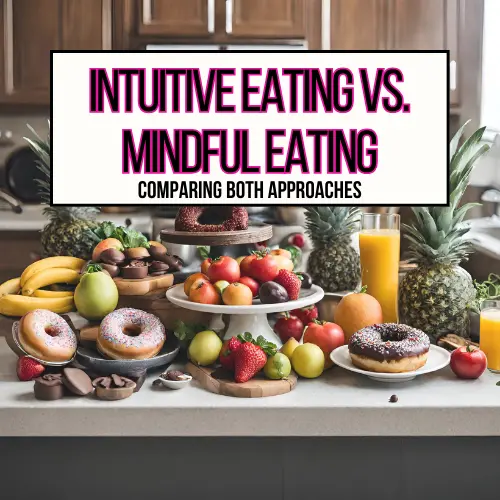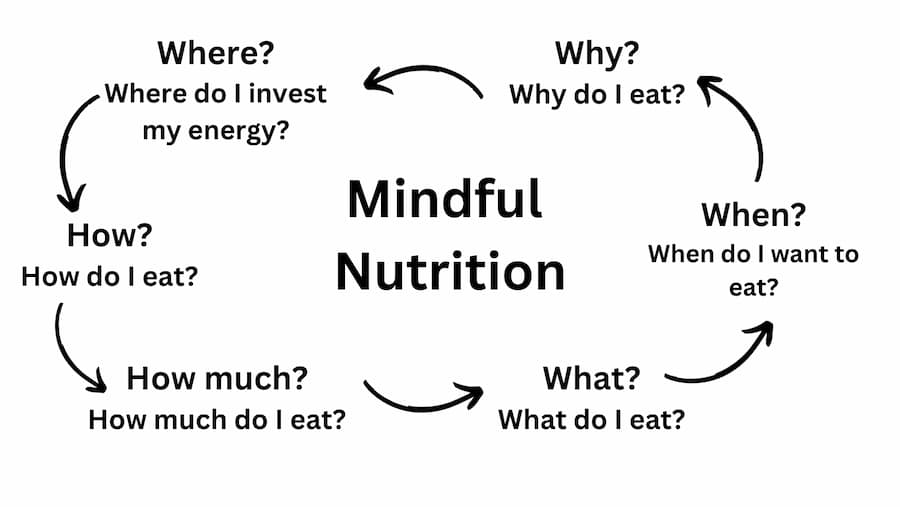Intuitive eating vs. mindful eating: what is the difference? Both approaches have the potential to address problematic eating behaviors and help to improve our relationship with food, however, they are not necessarily one and the same.
Mindful eating focuses on the entire eating experience itself, while intuitive eating is a more full body approach and consists of 10 principles. Both rely on internal hunger and fullness cues to guide how much to eat.
In short, it has been stated that intuitive eating is more broad – with a lot more components to it than just honoring your hunger and fullness cues.

If you’re tired of dieting and want to feel food freedom, this post will explore each approach to eating, what the current research has shown with each style of eating, the similarities and the differences.
Understanding Intuitive Eating
What is Intuitive Eating?
Intuitive eating is a flexible, weight-inclusive approach to eating which works by increasing awareness to the physical sensations of how we eat and removing rules, beliefs and thoughts which might disrupt that awareness.
The framework was created by two dietitians, Evelyn Tribole and Elyse Resch, in 1995. It consists of 10 principles developed to help counteract the negative mental and physical effects of diet culture.
The intuitive eating approach is often used to treat disordered eating, as the primary goal is to make peace with all types of food.
The 10 Intuitive Eating Principles
What Does the Research Say About Intuitive Eating?
A meta-analysis of 97 studies associated intuitive eating with higher self-esteem, body image, and well-being.
Recently, a longitudinal study examined the psychological benefits of intuitive eating and concluded that this style of eating can improve psychological health and reduce disordered eating behaviors – particularly binge eating.
Some research has found it may actually help improve diet quality and increase fruit and vegetable consumption because of the increased awareness of psychological cues, decreased emotional eating and binge eating.
Exploring Mindful Eating
University of Massachusetts researcher Jon Kabat-Zinn is widely acknowledged as the founding father of mindfulness, and established the Center for Mindfulness in the late 1970s. He created mindful eating exercises for food which paved the way for bringing more intention to meal times.
Mindful eating is the practice of paying attention to your food and the entire eating experience without judgment. It sounds simple, right? However, changing one’s entire eating experience takes time and practice.
Mindful Eating Principles

Mindful eating is all about being fully present during the entire eating experience. The focus is on where your food came from, how it feels when eating it, and understanding your body’s fullness cues.
An important aspect to eating mindfully is removing distractions while eating, chewing slowly, and savoring each bite of food.
Jon Kabat-Zinn created this mindful eating exercise involving a simple raisin to help people to understand his approach. Start slowly, with one meal or snack per day, and gradually increase to all meals.

What Does the Research Say About Mindful Eating?
Like intuitive eating, the eating mindfully approach has the potential to address problematic eating behaviors and challenges many face with controlling their intake. A literature review found that there is strong evidence for the efficacy of mindfulness in reducing the frequency and intensity of binge eating symptoms.
Intuitive Eating vs. Mindful Eating: What Are the Main Differences?

The practices of mindful eating (ME) and intuitive eating (IE) were both developed to minimize external drivers of energy intake by helping individuals emphasize the sensory properties of foods and internal indicators of hunger and fullness.
However, intuitive eating is a bit of a broader approach than mindful eating. It takes the entire body into account and incorporates principles like rejecting diet culture and exercise.
Some may say that mindful eating is actually incorporated into intuitive eating- where the goal is to eat when you are hungry and be able to tell when you are full.
Similarities between mindful and intuitive eating
Intuitive eating and mindful eating are often confused with one another because there are many similiarities.
Both approaches do not put restrictions on foods, and rely on internal hunger and fullness cues to guide how much to eat.
Then, there is the potential to decrease disordered eating and learn to eat food for enjoyment instead of as an emotional response.
These two styles of eating can improve one’s relationship with food – especially after years of exposure to diet culture.
Can Mindful Eating and Intuitive Eating Promote Weight Loss?
Mindfulness, as well as intuitive eating, are quickly becoming popular strategies to changing peoples’ eating behavior with food. However, weight loss is not typically considered an outcome for mindful or intuitive eating.
That being said, many people come to find that by improving their relationship with food and removing that emotional aspect of eating results in healthy weight changes.
Even further, a meta-analysis published in 2019 concluded that intuitive eating/mindful eating could be a practical approach to weight control.
There was mention of limitations in this study, and the relationship between weight loss and these eating practices is still unclear.
Real-Life Testimonials of Intuitive Eating Vs. Mindful Eating
Both of these approaches to eating get positive results! People who have adapted an intuitive eating approach rave about feeling healthier physically and mentally.
At the beginning of an intuitive eating journey, one might overindulge often – but eventually learn that they don’t want to eat an entire bag of chips because it makes them feel a certain way.
There is no longer stress about social settings with indulgent foods available. They’re able to control themselves and listen to their body’s wants and needs.
That addiction to food slowly dissipates, and intuitive/mindful eaters see food as food – and not a cure for their emotional feelings.
Wrapping It Up
So in conclusion, you don’t necessarily have to choose between intuitive eating or mindful eating. Both can be incorporated into your lifestyle with the potential to reduce emotional or disordered eating!
You can explore the various principles in each of these adaptive eating styles and figure out what works for you.
With the rise of social media and diet culture over the past decade, I think these two approaches will only rise in their popularity.



